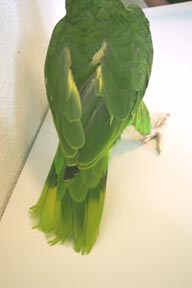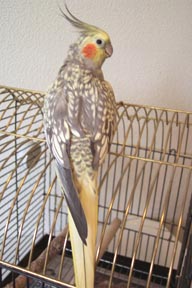WHY SHOULD I HAVE MY BIRD'S WINGS CLIPPED?
We see far more birds that have been injured when they can fly than when they are clipped. Flighted birds may hit ceiling fans, get shut in doors, fly into windows or sliding glass doors, or escape outside. When a pet bird flies loose outdoors, it will often become disoriented and scared, and may fly away even when the owner is standing nearby calling to it.
Many people argue that it is unkind to trim a bird's wings, but I feel it is no more unkind than keeping a dog on a leash or in a fenced yard. It is an issue of safety. Birds that cannot fly may become more bonded with their owner since they will depend on a human to pick them up off the floor, or to take them where they want to go. Aggressive birds may feel less dominant when they can't fly to attack. Wing trimming is as painless as a haircut, and the feathers will grow back when the bird molts. It is important to watch for feathers that may have grown back before taking a bird outside.
One drawback of wing trimming is that the bird is more likely to break a blood feather. For information on what to do when that happens, see our page on emergencies.
Close this page to return to other questions.
Here is an Amazon with unclipped wings. On larger, heavy bodied birds like this, we usually cut the first six feathers starting at the outside edge of the wing. Stronger flyers and light weight birds like Cockatiels and Conures require eight feathers cut.
Here is the same bird with six feathers trimmed. Notice that we do not cut into the row of smaller feathers above the row of flight feathers. That way, we can avoid cutting into the blood supply of any new feathers that are still growing.
How should a wing trim look when done correctly?
In some species, it is difficult to tell if the wing is adequately clipped when the wings are against the body. The Amazon on the left has one wing trimmed while the other wing is fully flighted. Can you tell which is which? It is much easier to tell on a longer, streamlined bird such as a cockatiel. You can see that her right wing feathers look much shorter than her left. We always trim both wings to give the bird better balance and a more symetrical appearance.
Our thanks to Curly Powell, the Mexican Red Head Amazon, and Spiker Powell, the pearl Cockatiel, for modeling for our wing trimming guide.
Burge Bird Services
Julie Burge, DVM
13833 S. 71 Hwy
Grandview, MO 64030
(816) 356-4700
http://BurgeBirdServices.homestead.com



